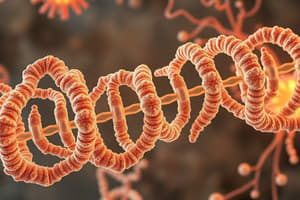Podcast
Questions and Answers
What is the primary function of eRF1 in translation termination?
What is the primary function of eRF1 in translation termination?
- Facilitating the movement of the ribosome
- Recognizing the stop codon (correct)
- Shifting tRNA between binding sites
- Incorporating amino acids into the polypeptide chain
What occurs if an incorrect amino acid is incorporated at the P site?
What occurs if an incorrect amino acid is incorporated at the P site?
- Correct amino acids will continue to be added afterward
- The ribosome will correct the tRNA without intervention
- A conformational change that enables termination can occur (correct)
- The polypeptide synthesis is immediately halted
Which mechanism does the ribosome utilize to move tRNA between sites?
Which mechanism does the ribosome utilize to move tRNA between sites?
- Shifting mechanism
- Sliding mechanism
- Ratcheting mechanism (correct)
- Swiveling mechanism
What is the role of eRF3 during translation termination?
What is the role of eRF3 during translation termination?
Which technique is NOT used to determine the 3D structure of a protein?
Which technique is NOT used to determine the 3D structure of a protein?
What does the 's' in 70s ribosome indicate?
What does the 's' in 70s ribosome indicate?
Which tRNA binding site is responsible for holding the newly arrived aminoacylated tRNA?
Which tRNA binding site is responsible for holding the newly arrived aminoacylated tRNA?
What protein facilitates the initial binding of the mRNA 5’ CAP during the formation of the pre-initiation complex?
What protein facilitates the initial binding of the mRNA 5’ CAP during the formation of the pre-initiation complex?
What happens when the A site of the ribosome is occupied by a correct tRNA?
What happens when the A site of the ribosome is occupied by a correct tRNA?
Which factor is responsible for bringing the charged tRNA to the A site?
Which factor is responsible for bringing the charged tRNA to the A site?
What initiates the formation of the 48s initiation complex during eukaryotic translation?
What initiates the formation of the 48s initiation complex during eukaryotic translation?
What is the role of the peptidyl-transferase center in the ribosome?
What is the role of the peptidyl-transferase center in the ribosome?
Which factor is removed by eIF5 during the transition to the 80s initiation complex?
Which factor is removed by eIF5 during the transition to the 80s initiation complex?
Flashcards
Translation
Translation
The process by which the genetic code in mRNA is translated into a polypeptide chain, creating a protein.
60S Ribosomal Subunit
60S Ribosomal Subunit
The large subunit of the eukaryotic ribosome, containing 50S ribosomal RNA.
40S Ribosomal Subunit
40S Ribosomal Subunit
The small subunit of the eukaryotic ribosome, containing 18S ribosomal RNA.
mRNA Binding Site
mRNA Binding Site
Signup and view all the flashcards
P Site (Peptidyl-tRNA Site)
P Site (Peptidyl-tRNA Site)
Signup and view all the flashcards
A Site (Aminoacylated tRNA Site)
A Site (Aminoacylated tRNA Site)
Signup and view all the flashcards
E Site (Exit Site)
E Site (Exit Site)
Signup and view all the flashcards
43S Pre-Initiation Complex
43S Pre-Initiation Complex
Signup and view all the flashcards
Ribosome Ratchet Mechanism
Ribosome Ratchet Mechanism
Signup and view all the flashcards
Translation Termination
Translation Termination
Signup and view all the flashcards
Kinetic Proofreading
Kinetic Proofreading
Signup and view all the flashcards
FLIM-FRET
FLIM-FRET
Signup and view all the flashcards
Protein Structure Determination
Protein Structure Determination
Signup and view all the flashcards
Study Notes
Ribosome Structure and Function
- Prokaryotic ribosomes = 70S, composed of 50S and 30S subunits.
- Eukaryotic ribosomes = 80S, composed of 60S and 40S subunits.
- "s" represents sedimentation rate, not a simple addition.
- Ribosomes have sites for RNA binding (1 mRNA, 3 tRNA).
- A site: Aminoacyl-tRNA
- P site: Peptidyl-tRNA
- E site: Exit site
Eukaryotic Translation Initiation
- mRNA exits nucleus to cytoplasm.
- eIF4 proteins (A/E/G) bind the 5' cap.
- eIF1, eIF2, and eIF3 join with the 40S subunit and Met-tRNA.
- 43S pre-initiation complex forms (eIF1, eIF2, eIF3, 40S subunit, Met-tRNA).
- 48S initiation complex forms (43S complex + eIF4A/E/G + mRNA at 5'UTR).
- Complex scans for the start codon (AUG) in the mRNA.
- Once AUG is at the P site, eIF5 releases initiation factors.
- 60S subunit joins 40S, forming 80S initiation complex.
Elongation
-
Charged tRNA enters the A site via EF-1α-GTP.
-
Kinetic proofreading:
- Correct tRNA: GTP hydrolyzed rapidly, EF-1α detaches.
- Incorrect tRNA: GTP hydrolyzed slowly, tRNA and EF-1α detach.
-
Peptide bond forms between amino acids in A and P sites (peptidyl transferase center, rRNA).
-
Ribosome moves (ratchet mechanism): P site tRNA to E site, A site tRNA to P site.
-
Large subunit moves first, followed by the small subunit.
Termination
- Stop codon reached.
- eRF1 recognizes stop codon.
- eRF3 facilitates polypeptide release (GTP dependent).
- Proofreading function:
- Incorrect tRNA in P site: eRF1 triggers termination despite incorrect amino acid.
- Incorrect amino acid: More changes and incorrect amino acid inclusion.
Techniques for studying protein structure and interactions
- FLIM-FRET: Measures distances with fluorescent probes.
- Other techniques for determining protein structure: Circular dichroism, NMR, electron microscopy, X-ray crystallography.
Studying That Suits You
Use AI to generate personalized quizzes and flashcards to suit your learning preferences.



